
Adobe, a leading software company, is exploring partnerships with artificial intelligence (AI) companies such as OpenAI and others to enhance its video editing software Premiere Pro. The new features include Object Addition & Removal and Generative Extend, which will allow users to add or remove objects in videos using text prompts and extend the length of clips respectively. Adobe's own generative AI model, Firefly, is being used for these features. However, the company is also considering integrations with third-party models like Pika and Sora from OpenAI. These tools could provide users with more choice and flexibility in their video editing projects.
Adobe's move to integrate third-party AI models follows a trend in the industry as both free and paid training data for AI companies is running out, leading to a potential crisis by 2026. Some companies have even resorted to generating synthetic data for training large language models (LLMs). However, this approach raises legal concerns as lawsuits have been filed against chatbot makers for using unlicensed material and shadow libraries.
Despite these challenges, Adobe's primary advantage lies in its extensive use of Firefly models within its software ecosystem. The integration of third-party AI models could benefit both Adobe and the AI companies by increasing accessibility to creative professionals who might not otherwise use separate dedicated apps.
It is important to note that while these new features offer exciting possibilities, they also come with potential risks. For instance, the removal of objects using generative AI may result in unwanted artifacts or inconsistencies. Additionally, the integration of third-party models could lead to issues related to data security and privacy.
Adobe's history of paying artists for content used to train its AI models raises questions about the ethical implications of using such data. The company has not disclosed whether it will continue this practice for its new video editing features. It is crucial that Adobe and other companies in the industry address these concerns transparently and responsibly as they develop and deploy new AI-powered tools.
:format(webp)/cdn.vox-cdn.com/uploads/chorus_asset/file/25394732/GenExtend_4.jpg)
:format(webp)/cdn.vox-cdn.com/uploads/chorus_asset/file/25394731/Remove_Object_3.jpg)
/cdn.vox-cdn.com/uploads/chorus_asset/file/25394730/Adobe_Firefly_for_Premiere_Pro.jpg)

